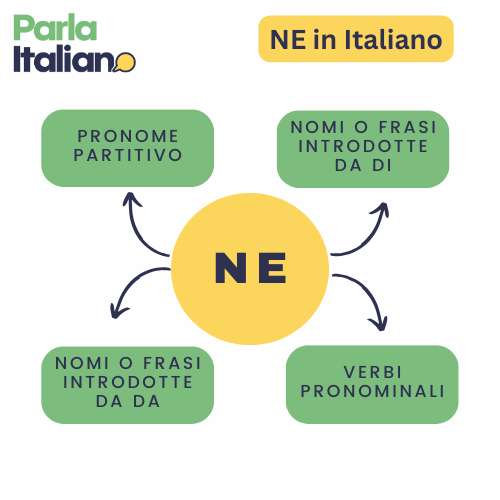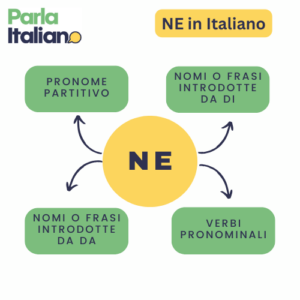In this lesson we analyse how to use the pronoun “ne” in Italian. More specifically we’ll look at “ne” when:
- it is the equivalent to the English some or any (partitive pronoun)
- it replaces a noun introduced by di or da
- it is used as part of pronominal verbs (andarsene, averne abbastanza, etc.)
We will also look at the position of ne in the sentence, give you some tips to make it easier for you to use, and to know when not to use it.
Ne is a pronoun, in other words, it is a term that replaces a word or sentence to avoid repetition.
Let’s see how to use ne in Italian.

.
1. Partitive pronoun
Ne is the equivalent of “some”, “any”, or “of it/of them”. It replaces expressions of amounts or quantities. It expresses the idea of being a part of something.
In Italian this is called “pronome partitivo”.
For example:
– Hai dei panini in casa? Sì, ne ho 5. (Do you have any rolls in the house? – Yes, I’ve got 5.)
Meaning of ne: of them, of all the potential rolls available, I have 5
ne = of them
.
The main differences between Italian and English
Notice that in Italian we must use ne, while in English it is not necessary, it is implied but not expressed.
.
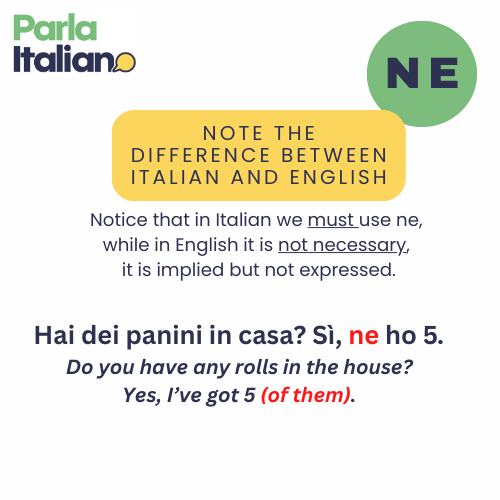
Further examples
Let’s see more examples to clarify further:
– Compri della zucca al mercato? → Sì, ne compro mezzo kilo.
(-Are you buying some pumpkin at the market? -Yes, I’ll buy half a kilo (of it))
Meaning of ne: of it, of all the pumpkin available at the market, I’ll buy half a kilo
ne = of it
– Vuoi del vino? → Ne voglio un bicchiere. (Do you want some wine? Yes, I want a glass (of it).)
Ne = of it, of the wine
– Hai comprato dei bei libri. → Sì, ne ho comprati dieci. (Have you bought some good books. → Yes, I’ve bought ten (of them).)
Ne = of them, of the books
– Hai mangiato troppa pasta? → Sì, ne ho mangiata troppa. (Have you eanten too much pasta? → Yes, I have eaten too much (of it).)
Ne = of it, of the pasta
.
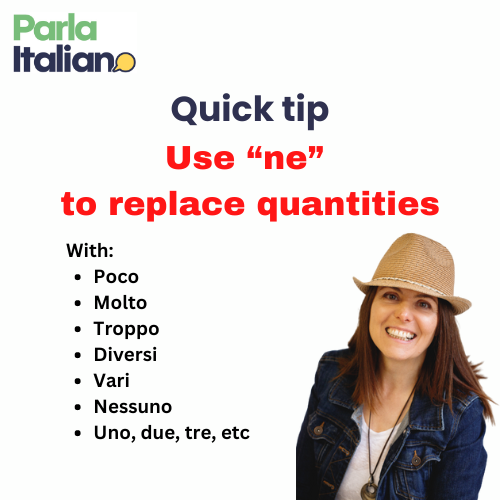
Quick tip
So, to summarise, ne is used to replace quantities.
A quick way of remembering to use ne, is when it replaces nouns preceded by a quantifier such as:
- Poco, pochi (a little/a few)
- Molto, molti (a lot, many)
- Troppo, troppi (too much/too many)
- Diversi (several)
- Vari (several)
- Nessuno (none, any)
- Uno, due, tre, etc
For example:
Conosco pochi spagnoli = ne conosco pochi
I know few Spaniards = I know few (of them)
Abbiamo 3 case = ne abbiamo tre.
We have 3 houses = we have 3 (of them)
Mangio troppa pasta = ne mangio troppa
.
When not to use NE
Note however, not to use ne with tutti (all). This is because all refers to the entirety and not only to a part of it. In this case you need the pronouns lo/la, li/le:
Vuoi dei panini? Sì, li voglio tutti.

Click here to arrange your course with me
.
2. Replaces a noun preceded by di or da
When is preceded by di
In this case the meaning of “ne” is of whom/of what and it is used with the function of specifying (of whom/of what).
A quick way to identify when to use it is to ask: di chi/di cosa?
(The best way is to ask the question in Italian and not in English as the prepositions in the two languages can be different)
Here are some examples:
Leo ti ha parlato di Angela? Sì, me ne ha parlato. Did Leo tell you about Angela? Yes, he told me.
Mi ha parlato di chi? Di Angela = ne
In order not to repeat “di Angela” we use “ne”
Further examples:
Hai bisogno di aiuto? Sì’, ne ho bisogno. (Do you need help? Yes, I need it)
Ne = di aiuto
Vuoi raccontare delle vacanze? Certo ne parlo volentieri. (Do you want to talk about holidays? Of course, I’ll talk happily about it)
Ne = delle vacanze
Hai paura dei pipistrelli? Sì, ne ho paura. (Are you afraid of bats? Yes, I am afraid of it.)
Ne = dei pipistrelli
.
When is preceded by da
It is used with the function of motion from a place (complemento di moto da luogo)
A che ora sei uscita dall’ufficio? Ne sono uscita alle 6. (What time did you leave the office? I left at 6)
Da che cosa sei uscita alle 6? Dall’ufficio
Quanto ritorni dalla conferenza? Ne ritorno domani. (When are you back from the conference? I’m back tomorrow)
Da che cosa ritorni domani? Dalla conferenza
Sei andata al museo? Sì, ne sono uscita ora. (Did you go to the museum? Yes, I’m leaving it now)
Da che cosa sono uscita ora? Dal museo
.
Replaces a full sentence
Ne can also replace a full sentence. See these two examples:
- L’esame è molto difficile, ne sono consapevole. (The exam was very difficult, I am aware of this.)
Ne= che l’esame è molto difficile
- Dici la verità? Ne dubito. (Are you telling the truth? I don’t believe it.)
Ne = che dici la verità.
.
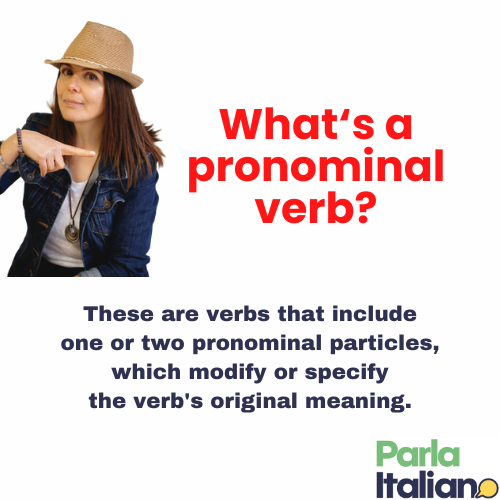
3. Use of ne with some pronominal verbs
In Italian we use ne with pronominal (or idiomatic) verbs. These are verbs that include one or two pronouns, which modify the verb’s original meaning.
For example andarsene is a pronominal verb made up of andare plus the reflexive pronoun si plus ne. The original verb andare means to go, but the meaning of andarsene is slightly different, it means to leave, to go away.
Let’s see three of these pronominal verbs which incorporate the pronoun NE.
We have chosen for you: fregarseme, non poterne più and averne abbastanza.
Fregarsene
Fregarsene conveys a sense of not caring or being indifferent about something. It’s an idiomatic expression used to indicate a lack of concern or interest in a matter. For example:
- Giorgio non lavora, non si occupa dei figli né della casa, se ne frega di tutto.
Se ne frega di tutto (He doesn’t care about anything)
Non poterne più
This means in English not to be able to take it anymore or to be fed up or to be at one’s limit. It conveys a sense of exhaustion, frustration, or being overwhelmed by a situation to the point where one feels they can’t endure it any longer. This expression reflects a state of emotional or physical exhaustion due to ongoing difficulties or challenges.
For example:
- Non ne posso più di questo traffico! Voglio cambiare città. (I can’t take this traffic anymore! I want to move to a different city.)
Averne abbastanza
This is a synonym of the previous, therefore it translates to “to have had enough” or “to be fed up”. It conveys a sense of reaching a limit or threshold of tolerance for something, where one can no longer endure a situation or circumstance.
- Non sopporto più le tue lamentele, ne ho abbastanza! (I can’t stand your complaints anymore, I’ve had enough!)
.
Conjugations
The conjugation of pronominal verbs includes the verb or phrase verb – which is conjugated as usual – accompanied by one or two pronouns. Here is a table with the full conjugation in the present tense.

In case you don’t yet know the basic conjugations of verbs, this site might help you.
.

.
4. Position of “Ne” in the sentence
Directly Before the Verb:
Generally, “ne” is placed directly before the conjugated verb in a sentence.
– Ho visto molte città, ne ho visitate alcune. (I’ve seen many cities, I’ve visited some (of them).)
– Hai bevuto caffè? Sì, ne ho bevuti due. (Have you had coffee? Yes, I have had two (of them).)
Added at the end:
It is added at the end of an infinitive verb (in other words a verb that ends in -are, -ere or -ire).
- Vuoi comprare dei pomodori? Sì, voglio comprarne tre. (Do you want to buy some tomatoes. Yes, I want to buy (3 of them))
It is also added at the end of an imperative verb (giving instructions or commands)
- Compra dei pomodori, comprane tre. (buy some tomatoes, buy 3 (of them))
Another pronoun that can be confusing for students is the pronoun “CI”. We have a full blog lesson on this as well. Click HERE to read it.

